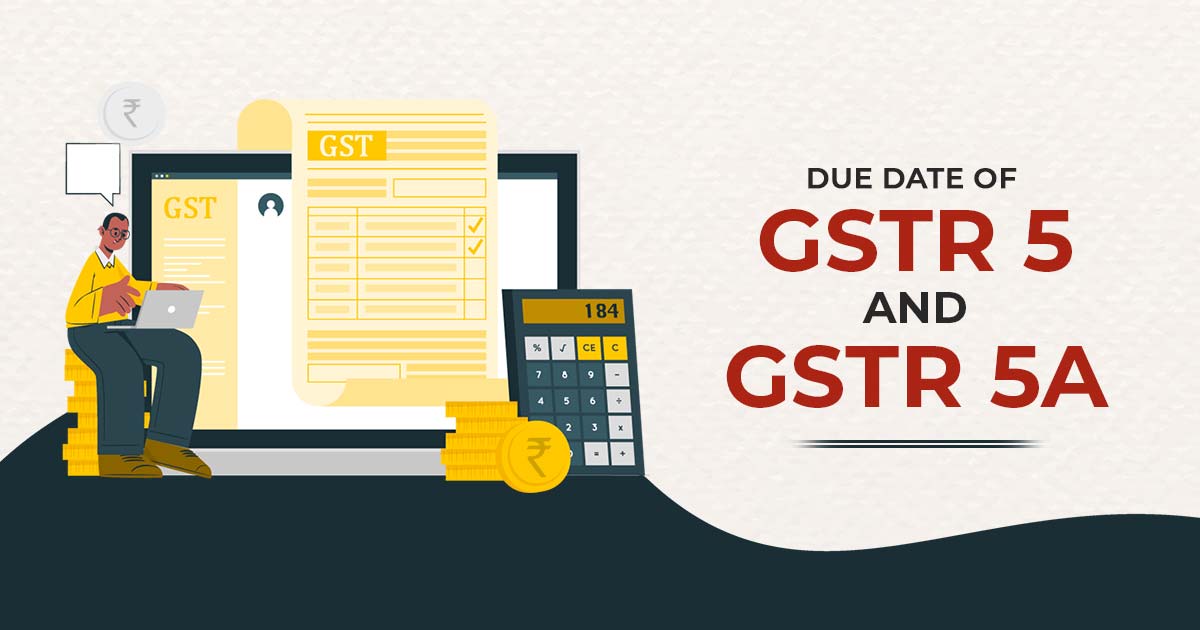
The GSTR-5 and GSTR-5A forms are crucial in the area of indirect taxes, particularly in the context of the Goods and Services Tax (GST) system in India, since they enable smooth compliance and open reporting. These two forms, which were created to record information on non-resident taxpayers and their transactions in the Indian tax system, are crucial parts of the GST system. The blog post has the objective to help GSTR 5 and 5A is a return form for the person registered under GST, and non-resident Foreign taxpayers are required to file on the 13th & 20th of the succeeding month.
The blog has the objective to help GSTR 5 and 5A is a return form for the person registered under GST, and non-resident Foreign taxpayers are required to file on the 13th & 20th of the succeeding month. Here, the CA portal provides all the GSTR 5A Form-related details along with rules and regulations, and compliance requirements, through a step-by-step online return filing procedure. The information about the GSTR 5 due date and GSTR 5A due date is been provided in the article.
In addition to GSTR-5, there is GSTR-5A, which is a crucial tool for tying the information about transactions and supplies provided by non-resident taxpayers in GSTR-5 to the information gathered by the Indian tax authorities. A summary of the supplies received from foreign businesses is presented to the recipient taxpayer in GSTR-5A, which is essentially an automatically created document. The same reconciliation process is important to validate the preciseness and consistency of the reported information by lessening the differences and facilitating a strong tax reporting regime.
What Are GSTR-5 and GSTR 5A?
GSTR-5: A non-resident taxable individual files the GSTR 5, which is a GST document, if who does business in India for a specific duration. Online GSTR 5 filings or filing through a tax facilitation facility are also options. The GSTR5 statement comprises information on the inbound and outward purchases and sales that the non-resident taxpayer made and received during business activities. The information described above should have given you a good understanding of what GSTR5 OR GSTR5A signifies. Let’s go on to further specifics, such as a non-resident taxable person, the GSTR 5 due date and filing requirements, etc.
Let’s start with the basics and first grasp who is a non-resident foreign taxpayer before we delve further into the meaning of GSTR 5. A non-resident taxpaying individual is one who:
- Is a tax-paying person who resides outside of India
- arrives in India for a little time to conduct sporadic business
- has no permanent office or presence in India
GSTR 5A: The GSTR-5A is a return form that must be submitted by a non-resident online information and database access or retrieval (OIDAR) service provider for services rendered to unregistered or non-taxable consumers from a location outside of India. It must be submitted by the deadline, which may be extended by the commissioner on the 20th of the month after the tax period to which the return pertains.
GSTR-5A for a certain tax period can only be filed after completing full tax payment and other liabilities if the return for the prior tax period has not been filed.
Who is Required to File Form GSTR 5 & GSTR 5A?
GSTR 5
A return in GSTR-5 would need to be filed by every registered non-resident taxable person in the GST portal. The same comprises all the information of the businesses for the non-residents (NR), as well as the information of the sales and purchases. Within the GSTR-2 buyers, the data from GSTR-5 would flow.
- For a lesser duration, a taxable non-resident who arrives in India performs occasional transactions.
- A GST-registered non-resident assessee who incurred OIDAR (Online Information Database Access and Retrieval supply before the non-taxable individual in India.
Pre-requisites to file the Form GSTR-5 would be
- The assessee would be enrolled as a Non-Resident taxable individual and must secure a valid GSTIN.
- The assessee must possess a valid User ID as well as a password.
- For the case of the assessee, the assessee must secure a valid and non-expired/ non-revoked Digital Signature Certificate (DSC) for whom digital signing is obligatory, like Companies, LLP/FLLP, In additional cases, return authentication could be performed via EVC.
GSTR 5A
It is obligated for the Non-Resident Online Information and Database Access or Retrieval (OIDAR) services provider to file the return in Form GSTR-5A. Compulsory return filing. Despite having no business activity, Form GSTR-5A would be required to get filed (i.e. it is a Nil Return) for a tax duration.
Towards the services furnished from a place outside India to a person in India, to unregistered persons or non-taxable customers. Non-resident Online Information and Database Access or Retrieval (OIDAR) services providers file the GSTR-5A, which is a return form. The same would get filed by the 20th of the month next to the tax duration to which the return relates or by the date as might get prolonged via the Commissioner.
Here are the Particulars of The GSTR 5 Format :
- GSTIN: In this section, one has to specify the Goods and Services Taxpayer Identification Number.
- Taxpayer’s name, the Validity period of registration, and the Tax period: This section has to contain the name of the registered taxpayer, who is the authorised signatory for one’s business under the GST law. And the duration for which one is filling the GSTR 5 also needs to be specified.
- Inputs received from Overseas: In this section, records of all the goods that have been imported need to be mentioned along with their HSN codes and all the pertinent documents like bills of entry.
- Services Imported: In this field, details of all the services imported from foreign suppliers must be mentioned.
- Outward Supplies: Outward supplies are the sales made by suppliers. In this section, one should record the details of all the sales that one has made in India. One should specify the details of all the registered buyers along with their GSTINs. The details of CGST, IGST, and SGST should be filled in separately.
- Credit & Debit Notes Details: In this section, the details of all the credit and debit notes raised in the association for one’s business transactions in India should be mentioned. One can modify the details of credit and debit notes under section 8A of the GSTR 5 Act.
- Tax Paid: This section needs to be filled with the details of tax paid under different GST components; SGST, CGST, and IGST. The tax liability for this can be calculated by the data provided in the previous sections.
- Closing Stocks: Details of the closing stocks should be mentioned in this section.
- Refund Claim: This section will contain the details of all the refunds that one has got from the electronic cash ledger.
Penalties For Filing Late of GSTR 5
You will be penalized with interest and a late filing fee if you wait too long to file. 18% is the yearly interest rate. Based on the amount of outstanding tax, the taxpayer must compute it. The deadline will be the day after filing (the 21st of the month), and it will last until payment is paid. For late payments, there are late fines of Rs. 50 per day and Rs. 20 for non-payment. There is a Rs. 5,000 maximum fine for being late.
If the GSTR-5 return is not submitted, the subsequent month’s return cannot be submitted. Due to the cascading consequences of late GST return submission, there will be fines and penalties.
Is There Any Difference Between GSTR 5 and GSTR 5A?
Yes, there is a little distinction between GSTR 5 and GSTR 5A. The most notable one is that GSTR 5 is a filing form that NRIs must submit on the thirteenth of each month, whereas GSTR 5A requests information on all sales and purchases on the 20th of the following month.
NRIs or providers of online information and database access or retrieval (OIDAR) services who offer their online services in India and generate revenue from such services must file Form GSTR 5A, which is a return form.
GSTR 5 Form Filing Due Dates For June 2025
Note: As of Budget 2022, the GSTR-5 return form is due on the 13th of the succeeding month rather than the 20th of the following month.
| Period (Monthly) | Due Dates |
|---|---|
| June 2025 | 13th July 2025 |
| May 2025 | 13th June 2025 |
| April 2025 | 13th May 2025 |
| March 2025 | 13th April 2025 |
| February 2025 | 13th March 2025 |
| January 2025 | 13th February 2025 |
| December 2024 | 15th January 2025 | Extended |
| November 2024 | 13th December 2024 |
| October 2024 | 13th November 2024 |
| September 2024 | 13th October 2024 |
| August 2024 | 13th September 2024 |
| July 2024 | 13th August 2024 |
| June 2024 | 13th July 2024 |
Latest Update
GSTR-5 returns for December 2024 have been extended by the Central Board of Indirect Taxes and Customs (CBIC), under the Ministry of Finance. Read the official notification

GSTR 5A Form Filing Due Dates For June 2025
| Period (Monthly) | Due Dates |
|---|---|
| June 2025 | 20th July 2025 |
| May 2025 | 20th June 2025 |
| April 2025 | 20th May 2025 |
| March 2025 | 20th April 2025 |
| February 2025 | 20th March 2025 |
| January 2025 | 20th February 2025 |
| December 2024 | 20th January 2025 |
| November 2024 | 20th December 2024 |
| October 2024 | 20th November 2024 |
| September 2024 | 20th October 2024 |
| August 2024 | 20th September 2024 |
| July 2024 | 20th August 2024 |
| June 2024 | 20th July 2024 |
| May 2024 | 20th June 2024 |








August 20, 2020
Where to show interest liability in GSTR-5A.
August 24, 2020
In table no. 7 you have to mention interest liability in GSTR 5A
August 16, 2018
GSTR 5 & GSTR 5A all details are approximately same. So why GSTR 5A came in. Please explain me in details the difference between GSTR 5 and 5A
August 17, 2018
The main difference between the GSTR 5 & 5A is – GSTR-5 is a periodic return to be filed by Non-Resident Taxable Person and GSTR-5A needs to be filed even if there is no business activity (NIL Return) in the tax period.
While the GSTR 5 is to be filed by the NRI who has a business in India while the GSTR 5A is for the Online Information and Database Access or Retrieval (OIDAR) Service Providers.